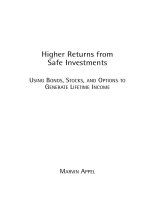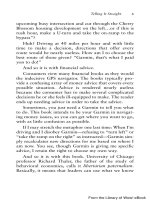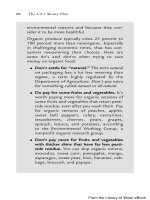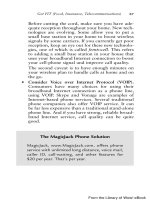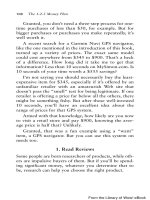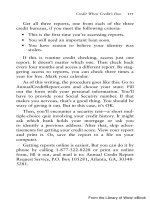ACCA LSBF f5 performance management section 1 2
Bạn đang xem bản rút gọn của tài liệu. Xem và tải ngay bản đầy đủ của tài liệu tại đây (730.67 KB, 102 trang )
LSB_F5 Performance Management_section 1:297mm x 210mm
28/8/09
12:58
Page 1
F5
Paper F5 Performance
Management
ACCA
LSB_F5 Performance Management_section 1:297mm x 210mm
28/8/09
12:58
Page 2
PERFORMANCE MANAGEMENT
British Library Cataloguing-in-Publication Data
A catalogue record for this book is available from the British Library
Published by InterActive World Wide Limited
Westgate House, 8-9 Holborn
London EC1N 2LL
www.iaww.com
www.studyinteractive.org
ISBN 978-1-907217-04-3
First Edition 2009
Printed in Romania
© 2009 InterActive World Wide Limited.
London School of Business & Finance and the LSBF logo are trademarks or registered trademarks of London
School of Business & Finance (UK) Limited in the UK and in other countries and are used under license.
All used brand names or typeface names are trademarks or registered trademarks of their respective holders.
All our rights reserved. No part of this publication may be reproduced, stored in a retrieval system, or
transmitted, in any form or by any means, electronic, mechanical, photocopying, recording or otherwise,
without the prior written permission of InterActive World Wide.
2
LSB_F5 Performance Management_section 1:297mm x 210mm
28/8/09
12:58
Page 3
FOREWORD
Foreword
Thank you for choosing to study with the London School of Business and Finance (LSBF).
A dynamic, quality-oriented and innovative educational institution, the London School of Business and Finance
offers specialised programmes, designed with students and employers in mind. We are always at the frontline
driving the latest professional developments and trends.
LSBF attracts the highest quality candidates from over 140 countries worldwide. We work in partnership with
leading accountancy firms, banks and best-practice organisations – enabling thousands of students to realise
their full potential in accountancy, finance and the business world.
With an international perspective, LSBF has developed a rich portfolio of professional qualifications and executive
education programmes. To complement our face-to-face and cutting-edge online learning products, LSBF is
now pleased to offer tailored study materials to support students in their preparation for exams.
The exam focused content in this manual will provide you with a comprehensive and up-to-date understanding
of the ACCA syllabus. We have an award-winning team of tutors, who are highly experienced in helping students
through their professional exams and have received consistently excellent feedback.
I hope that you will find this manual helpful and wish you the best of luck in your studies.
Aaron Etingen
ACCA, MSI, Founder and CEO
3
LSB_F5 Performance Management_section 1:297mm x 210mm
PERFORMANCE MANAGEMENT
4
28/8/09
12:58
Page 4
LSB_F5 Performance Management_section 1:297mm x 210mm
28/8/09
12:59
Page 5
CONTENTS
Contents
Foreword
3
About ACCA Paper F5 - Performance Management
7
Contents
Syllabus and Study Guide
Pilot Paper
Formulae Sheet
5
11
25
43
Chapter 1 - Session 1 parts 1 and 2 - Activity Based Costing (ABC)
47
Chapter 3 - Session 1 part 3 - Life Cycle and Target Costing
71
Chapter 2 - Session 1 part 3 - Backflush and Throughput Accounting
Chapter 4 - Session 2 - Marginal Costs and Relevant Costs
Chapter 5 - Session 2 - Linear Programming
61
81
103
Chapter 6 - Session 2 - Pricing Decisions
121
Chapter 8 - Session 4 - Budgeting
153
Chapter 7 - Session 2 - Decision Making Under Uncertainty
137
Chapter 9 - Quantitive Aids to Budgeting
173
Chapter 11 - Advanced Variance Analysis
215
Feedback and Review Form
259
Chapter 10 - Basic Variance Analysis
Chapter 12 - Performance Measurement
193
237
5
LSB_F5 Performance Management_section 1:297mm x 210mm
PERFORMANCE MANAGEMENT
6
28/8/09
12:59
Page 6
LSB_F5 Performance Management_section 1:297mm x 210mm
28/8/09
12:59
Page 7
F5
About ACCA
Paper F5 Performance
Management
LSB_F5 Performance Management_section 1:297mm x 210mm
PERFORMANCE MANAGEMENT
8
28/8/09
12:59
Page 8
LSB_F5 Performance Management_section 1:297mm x 210mm
28/8/09
12:59
Page 9
ABOUT ACCA PAPER F5 - PERFORMANCE MANAGEMENT
Aim of the Paper
The aim of the paper is to introduce knowledge and understanding of management accounting.The paper develops
knowledge and understanding of how to prepare and calculate costing information for use within a business.
Outline of the Syllabus
Explain the nature of cost and management accounting
Explain the purpose of cost and management accounting
Identify and describe costs by classification, behaviour and purpose
Explain and apply cost accounting techniques
Prepare and coordinate budgets for feedback and control
Use management accounting techniques to make and support decision making
Format of the Exam Paper
The syllabus is assessed by a two hour computer-based examination.
The examination consists of a mixture of 2 mark and 1 mark questions.
There will be 40 compulsory 2 mark questions
There will be 10 compulsory 1 mark questions
Getting the most from your studies
Manage your time effectively. If you have a busy work schedule use your study planner to catch up. Do not
allow yourself to fall behind.
Make sure that you can apply all the numbers to the formulae and can perform the calculations accurately
Practice as many questions as you can. You should aim to have attempted every question in the revision kit at
least twice before the exam.
9
LSB_F5 Performance Management_section 1:297mm x 210mm
PERFORMANCE MANAGEMENT
10
28/8/09
12:59
Page 10
LSB_F5 Performance Management_section 1:297mm x 210mm
28/8/09
12:59
Page 11
F5
Syllabus and
Study Guide
LSB_F5 Performance Management_section 1:297mm x 210mm
PERFORMANCE MANAGEMENT
12
28/8/09
12:59
Page 12
LSB_F5 Performance Management_section 1:297mm x 210mm
28/8/09
12:59
Page 13
SYLLABUS AND STUDY GUIDE
Performance Management (F5)
This syllabus and study guide is designed to help with planning study and to provide detailed information on
what could be assessed in any examination session.
The Structure of the Syllabus and Study Guide
RELATIONAL DIAGRAM OF PAPER WITH OTHER PAPERS
This diagram shows direct and indirect links between this paper and other papers preceding or following it.
Some papers are directly underpinned by other papers such as Advanced Performance Management by
Performance Management. These links are shown as solid line arrows. Other papers only have indirect
relationships with each other such as links existing between the accounting and auditing papers. The links
between these are shown as dotted line arrows.This diagram indicates where you are expected to have
underpinning knowledge and where it would be useful to review previous learning before undertaking study.
OVERALL AIM OF THE SYLLABUS
This explains briefly the overall objective of the paper and indicates in the broadest sense the capabilities to
be developed within the paper.
MAIN CAPABILITIES
This paper’s aim is broken down into several main capabilities which divide the syllabus and study guide into
discrete sections.
RELATIONAL DIAGRAM OF THE MAIN CAPABILITIES
This diagram illustrates the flows and links between the main capabilities (sections) of the syllabus and should
be used as an aid to planning teaching and learning in a structured way.
SYLLABUS RATIONALE
This is a narrative explaining how the syllabus is structured and how the main capabilities are linked. The
rationale also explains in further detail what the examination intends to assess and why.
DETAILED SYLLABUS
This shows the breakdown of the main capabilities (sections) of the syllabus into subject areas. This is the
blueprint for the detailed study guide.
APPROACH TO EXAMINING THE SYLLABUS
This section briefly explains the structure of the examination and how it is assessed.
STUDY GUIDE
This is the main document that students, tuition providers and publishers should use as the basis of their
studies, instruction and materials. Examinations will be based on the detail of the study guide which
comprehensively identifies what could be assessed in any examination session. The study guide is a precise
reflection and breakdown of the syllabus. It is divided into sections based on the main capabilities identified in the
syllabus. These sections are divided into subject areas which relate to the sub-capabilities included in the detailed
syllabus. Subject areas are broken down into sub-headings which describe the detailed outcomes that could be
assessed in examinations. These outcomes are described using verbs indicating what exams may require
students to demonstrate, and the broad intellectual level at which these may need to be demonstrated (*see
intellectual levels overleaf).
13
LSB_F5 Performance Management_section 1:297mm x 210mm
28/8/09
12:59
Page 14
PERFORMANCE MANAGEMENT
Intellectual Levels
The syllabus is designed to progressively broaden and deepen the knowledge, skills and professional values
demonstrated by the student on their way through the qualification.
The specific capabilities within the detailed syllabuses and study guides are assessed at one of three intellectual
or cognitive levels:
Level 1: Knowledge and comprehension
Level 2:Application and analysis
Level 3: Synthesis and evaluation
Very broadly, these intellectual levels relate to the three cognitive levels at which the Knowledge module, the
Skills module and the Professional level are assessed.
Each subject area in the detailed study guide included in this document is given a 1, 2, or 3 superscript, denoting
intellectual level, marked at the end of each relevant line. This gives an indication of the intellectual depth at
which an area could be assessed within the examination. However, while level 1 broadly equates with the
Knowledge module, level 2 equates to the Skills module and level 3 to the Professional level, some lower level
skills can continue to be assessed as the student progresses through each module and level. This reflects that
at each stage of study there will be a requirement to broaden, as well as deepen capabilities. It is also possible
that occasionally some higher level capabilities may be assessed at lower levels.
Learning Hours
The ACCA qualification does not prescribe or recommend any particular number of learning hours for
examinations because study and learning patterns and styles vary greatly between people and organisations.
This also recognises the wide diversity of personal, professional and educational circumstances in which ACCA
students find themselves.
Each syllabus contains between 23 and 35 main subject area headings depending on the nature of the subject
and how these areas have been broken down.
Guide to Exam Structure
The structure of examinations varies within and between modules and levels.
The Fundamentals level examinations contain 100% compulsory questions to encourage candidates to study
across the breadth of each syllabus.
The Knowledge module is assessed by equivalent two-hour paper based and computer based examinations.
The Skills module examinations are all paper based three-hour papers. The structure of papers varies from ten
questions in the Corporate and Business Law (F4) paper to four 25 mark questions in Financial Management (F9).
Individual questions within all Skills module papers will attract between 10 and 30 marks.
The Professional level papers are all three-hour paper based examinations, all containing two sections. Section
A is compulsory, but there will be some choice offered in Section B.
For all three hour examination papers,ACCA has introduced 15 minutes reading and planning time.
This additional time is allowed at the beginning of each three-hour examination to allow candidates to read the
questions and to begin planning their answers before they start writing in their answer books. This time should
be used to ensure that all the information and exam requirements are properly read and understood.
During reading and planning time candidates may only annotate their question paper. They may not write
anything in their answer booklets until told to do so by the invigilator.
The Essentials module papers all have a Section A containing a major case study question with all requirements
totalling 50 marks relating to this case. Section B gives students a choice of two from three 25 mark questions.
14
LSB_F5 Performance Management_section 1:297mm x 210mm
28/8/09
12:59
Page 15
SYLLABUS AND STUDY GUIDE
Section A of each of the Options papers contains 50-70 compulsory marks from two questions, each attracting
between 25 and 40 marks. Section B will offer a choice of two from three questions totalling 30-50 marks, with
each question attracting between 15 and 25 marks.
The pass mark for all ACCA Qualification examination papers is 50%.
Guide to Examination Assessment
ACCA reserves the right to examine anything contained within the study guide at any examination session.
This includes knowledge, techniques, principles, theories, and concepts as specified.
For the financial accounting, audit and assurance, law and tax papers except where indicated otherwise, ACCA
will publish examinable documents once a year to indicate exactly what regulations and legislation could
potentially be assessed within identified examination sessions.
For paper based examinations regulation issued or legislation passed on or before 30th September annually,
will be assessed from June 1st of the following year to May 31st of the year after. Therefore, paper based
examinations in June 2009, December 2009 (and March 2010 where applicable) will be assessed on regulations
issued and legislation passed on or before 30 September 2008.
Regulation issued or legislation passed in accordance with the above dates may be examinable even if the
effective date is in the future.
The term issued or passed relates to when regulation or legislation has been formally approved.
The term effective relates to when regulation or legislation must be applied to an entity transactions and
business practices.
The study guide offers more detailed guidance on the depth and level at which the examinable documents will
be examined. The study guide should therefore be read in conjunction with the examinable documents list.
Relational Diagram of Paper with Other Papers
APM (P5)
PM (F5)
MA (F2)
Aim
To develop knowledge and skills in the application of management accounting techniques to quantitative and
qualitative information for planning, decision-making, performance evaluation, and control
15
LSB_F5 Performance Management_section 1:297mm x 210mm
28/8/09
12:59
Page 16
PERFORMANCE MANAGEMENT
Main Capabilities
On successful completion of this paper candidates should be able to:
A Explain, apply, and evaluate cost accounting techniques
B Select and appropriately apply decision-making techniques to evaluate business choices and promote
efficient and effective use of scarce business resources, appreciating the risks and uncertainty inherent in
business and controlling those risks
C Apply budgeting techniques and evaluate alternative methods of budgeting, planning and control
D Use standard costing systems to measure and control business performance and to identify remedial action
E Assess the performance of a business from both a financial and non-financial viewpoint, appreciating the
problems of controlling divisionalised businesses and the importance of allowing for external aspects.
Relational Diagram of Main Capabilities
Specialist cost and
management accounting
techniques (A)
Decision-making
techniques (B)
Budgeting (C)
Performance
measurement
and control (E)
Standard costing and
variance analysis (D)
Rationale
The syllabus for Paper F5, Performance Management, builds on the knowledge gained in Paper F2, Management
Accounting. It also prepares candidates for more specialist capabilities which are covered in P5 Advanced
Performance Management.
The syllabus begins by introducing more specialised management accounting topics. There is some knowledge
assumed from Paper F2 – primarily overhead treatments. The objective here is to ensure candidates have a
broader background in management accounting techniques.
The syllabus then considers decision-making. Candidates need to appreciate the problems surrounding scarce
resource, pricing and make-or-buy decisions, and how this relates to the assessment of performance. Risk and
uncertainty are a factor of real-life decisions and candidates need to understand risk and be able to apply some
basic methods to help resolve the risks inherent in decision-making.
Budgeting is an important aspect of many accountants’ lives. The syllabus explores different budgeting techniques
and the problems inherent in them. The behavioural aspects of budgeting are important for accountants to
understand, and the syllabus includes consideration of the way individuals react to a budget.
16
LSB_F5 Performance Management_section 1:297mm x 210mm
28/8/09
12:59
Page 17
SYLLABUS AND STUDY GUIDE
Standard costing and variances are then built on. All the variances examined in Paper F2 are examinable here.
The new topics are mix and yield variances, and planning and operational variances. Again, the link is made to
performance management. It is important for accountants to be able to interpret the numbers that they
calculate and ask what they mean in the context of performance.
The syllabus concludes with performance measurement and control. This is a major area of the syllabus.
Accountants need to understand how a business should be managed and controlled. They should appreciate
the importance of both financial and non-financial performance measures in management. Accountants should
also appreciate the difficulties in assessing performance in divisionalised businesses and the problems caused by
failing to consider external influences on performance. This section leads directly to Paper P5.
Detailed Syllabus
A
SPECIALIST COST AND MANAGEMENT ACCOUNTING TECHNIQUES
B
DECISION-MAKING TECHNIQUES
C
D
E
1.
2.
3.
4.
5.
Activity-based costing
Target costing
Life-cycle costing
Back-flush accounting
Throughput accounting
1.
2.
3.
4.
Multi-limiting factors and the use of linear programming and shadow pricing
Pricing decisions
Make-or-buy and other short-term decisions
Dealing with risk and uncertainty in decision- making
1.
2.
3.
4.
5.
Objectives
Budgetary systems
Types of budget
Quantitative analysis in budgeting
Behavioural aspects of budgeting
1.
2.
3.
4.
5.
Budgeting and standard costing
Basic variances and operating statements
Material mix and yield variances
Planning and operational variances
Behavioural aspects of standard costing
1.
2.
3.
4.
The scope of performance measurement
Divisional performance and transfer pricing
Performance analysis in not-for-profit organisations and the public sector
External considerations and behavioural aspects
BUDGETING
STANDARD COSTING AND VARIANCES ANALYSIS
PERFORMANCE MEASUREMENT AND CONTROL
17
LSB_F5 Performance Management_section 1:297mm x 210mm
28/8/09
12:59
Page 18
PERFORMANCE MANAGEMENT
Approach to Examining the Syllabus
Paper F5, Performance Management, seeks to examine candidates’ understanding of how to manage the
performance of a business.
The paper builds on the knowledge acquired in Paper F2, Management Accounting, and prepares those candidates
who choose to study Paper P5, Advanced Performance Management, at the Professional level
The syllabus is assessed by a three-hour paper-based examination.
The examination will contain five compulsory 20-mark questions. There will be calculation and discursive
elements to the paper with the balance being broadly in line with the pilot paper. The pilot paper contains
questions from four of the five syllabus sections. Generally, the paper will seek to draw questions from as many
of the syllabus sections as possible.
18
LSB_F5 Performance Management_section 1:297mm x 210mm
28/8/09
12:59
Page 19
SYLLABUS AND STUDY GUIDE
STUDY GUIDE
A
Specialist Cost and Management Accounting Techniques
1.
ACTIVITY BASED COSTING
a) Identify appropriate cost drivers under ABC. [1]
b) Calculate costs per driver and per unit using ABC. [2]
c) Compare ABC and traditional methods of overhead absorption based on production units, labour hours or
machine hours. [2]
d) Explain the implications of switching to ABC for pricing, sales strategy, performance management and
decision-making. [2]
2.
TARGET COSTING
a)
b)
c)
d)
3.
Derive a target cost in manufacturing and service industries. [2]
Explain the difficulties of using target costing in service industries. [2]
Explain the implications of using target costing on pricing, cost control and performance management. [2]
Suggest how a target cost gap might be closed. [2]
LIFE-CYCLE COSTING
a) Identify the costs involved at different stages of the life-cycle.[2]
b) Explain the implications of lifecycle costing on pricing, performance management and decision-making.[2]
4.
BACK-FLUSH ACCOUNTING
a) Describe the process of back-flush accounting and contrast with traditional process accounting. [2]
b) Explain the implications of back-flush accounting on performance management and the control of a
manufacturing process. [2]
c) Identify the benefits of introducing back- flush accounting. [2]
d) Evaluate the decision to switch to back-flush accounting from traditional process control. [3]
5.
THROUGHPUT ACCOUNTING
a) Calculate and interpret a throughput accounting ratio (TPAR). [2]
b) Suggest how a TPAR could be improved. [2]
c) Apply throughput accounting to a multi-product decision-making problem. [2]
B
Decision-Making Techniques
1.
MULTI-LIMITING FACTORS AND THE USE OF LINEAR PROGRAMMING AND SHADOW PRICING
a) Select an appropriate technique in a scarce resource situation. [2]
b) Formulate and solve a multiple scarce resource problem both graphically and using simultaneous equations
as appropriate. [2]
c) Explain and calculate shadow prices (dual prices) and discuss their implications on decision-making and
performance management. [2]
d) Calculate slack and explain the implications of the existence of slack for decision-making and performance
management. [2]
(Excluding simplex and sensitivity to changes in objective functions)
19
LSB_F5 Performance Management_section 1:297mm x 210mm
28/8/09
12:59
Page 20
PERFORMANCE MANAGEMENT
2.
PRICING DECISIONS
a) Explain the factors that influence the pricing of a product or service. [2]
b) Explain the price elasticity of demand. [1]
c) Derive and manipulate a straight line demand equation. Derive an equation for the total cost function
(including volume-based discounts). [2]
d) Evaluate a decision to increase production and sales levels, considering incremental costs, incremental
revenues and other factors. [2]
e) Explain different price strategies, including: [2]
i)
All forms of cost-plus
ii)
Skimming
iii)
Penetration
iv)
Complementary product
v)
Product-line
vi)
Volume discounting
vii) Discrimination
viii) Relevant cost
f) Calculate a price from a given strategy using cost-plus and relevant cost. [2]
3.
MAKE-OR-BUY AND OTHER SHORT-TERM DECISIONS
a) Explain the issues surrounding make vs. buy and outsourcing decisions. [2]
b) Calculate and compare “make” costs with “buy-in” costs. [2]
c) Compare in-house costs and outsource costs of completing tasks and consider other issues surrounding
this decision. [2]
d) Apply relevant costing principles in situations involving shut down, one-off contracts and the further
processing of joint products. [2]
4.
DEALING WITH RISK AND UNCERTAINTY IN DECISION-MAKING
a)
b)
c)
d)
Suggest research techniques to reduce uncertainty e.g. Focus groups, market research .[2]
Explain the use of simulation, expected values and sensitivity. [1]
Apply expected values and sensitivity to decision-making problems. [2]
Apply the techniques of maximax, maximin, and minimax regret to decision-making problems including the
production of profit tables. [2]
(Excluding decision trees and the value of perfect information)
C
Budgeting
1.
OBJECTIVES
a) Outline the objectives of a budgetary control system. [2]
b) Explain how corporate and divisional objectives may differ and can be reconciled. [2]
c) Identify and resolve conflicting objectives and explain implications. [2]
20
LSB_F5 Performance Management_section 1:297mm x 210mm
28/8/09
12:59
Page 21
SYLLABUS AND STUDY GUIDE
2.
BUDGETARY SYSTEMS
a) Explain how budgetary systems fit within the performance hierarchy. [2]
b) Select and explain appropriate budgetary systems for an organisation, including top-down, bottom-up,
rolling, zero-base, activity- base, incremental and feed-forward control. [2]
c) Describe the information used in budget systems and the sources of the information needed. [2]
d) Explain the difficulties of changing a budgetary system. [2]
e) Explain how budget systems can deal with uncertainty in the environment. [2]
3.
TYPES OF BUDGET
a) Indicate the usefulness and problems with different budget types (zero-base, activity- based, incremental,
master, functional and flexible). [2]
b) Explain the difficulties of changing the type of budget used. [2]
4.
QUANTITATIVE ANALYSIS IN BUDGETING
a) Analyse fixed and variable cost elements from total cost data using high/low and regression methods. [2]
b) Explain the use of forecasting techniques, including time series, simple average growth models and estimates
based on judgement and experience. Predict a future value from provided time series analysis data using
both additive and proportional data. [2]
c) Estimate the learning effect and apply the learning curve to a budgetary problem, including calculations on
steady states [2]
d) Discuss the reservations with the learning curve. [2]
e) Apply expected values and explain the problems and benefits. [2]
f) Explain the benefits and dangers inherent in using spreadsheets in budgeting. [1]
5.
BEHAVIOURAL ASPECTS OF BUDGETING
a) Identify the factors which influence behaviour. [2]
b) Discuss the issues surrounding setting the difficulty level for a budget. [2]
c) Explain the benefits and difficulties of the participation of employees in the negotiation of targets. [2]
D
Standard Costing and Variances Analysis
1.
BUDGETING AND STANDARD COSTING
a)
b)
c)
d)
e)
f)
2.
Explain the use of standard costs. [2]
Outline the methods used to derive standard costs and discuss the different types of cost possible. [2]
Explain the importance of flexing budgets in performance management. [2]
Prepare budgets and standards that allow for waste and idle time. [2]
Explain and apply the principle of controllability in the performance management system. [2]
Prepare a flexed budget and comment on its usefulness. [2]
BASIC VARIANCES AND OPERATING STATEMENTS
a) Calculate, identify the cause of and interpret basic variances: [1]
i) Sales price and volume
ii) Materials total, price and usage
iii) Labour total, rate and efficiency
21
LSB_F5 Performance Management_section 1:297mm x 210mm
28/8/09
12:59
Page 22
PERFORMANCE MANAGEMENT
b)
c)
d)
e)
f)
g)
3.
MATERIAL MIX AND YIELD VARIANCES
a)
b)
c)
d)
4.
iv) Variable overhead total, expenditure and efficiency
v) Fixed overhead total, expenditure and, where appropriate, volume, capacity and efficiency.
Explain the effect on labour variances where the learning curve has been used in the budget process. [2]
Produce full operating statements in both a marginal cost and full absorption costing environment, reconciling
actual profit to budgeted profit. [2]
Calculate the effect of idle time and waste on variances including where idle time has been budgeted for. [2]
Explain the possible causes of idle time and waste and suggest methods of control. [2]
Calculate, using a simple situation,ABC-based variances. [3]
Explain the different methods available for deciding whether or not too investigate a variance cause. [2]
Calculate, identify the cause of, and explain mix and yield variances. [2]
Explain the wider issues involved in changing mix e.g. cost, quality and performance measurement issues. [2]
Identify and explain the interrelationship between price, mix and yield. [2]
Suggest and justify alternative methods of controlling production processes. [2]
PLANNING AND OPERATIONAL VARIANCES
a) Calculate a revised budget. [2]
b) Identify and explain those factors that could and could not be allowed to revise an original budget. [2]
c) Calculate planning and operational variances for sales, including market size and market share materials and
labour. [2]
d) Explain and the manipulation issues in revising budgets. [2]
5.
BEHAVIOURAL ASPECTS OF STANDARD COSTING
a) Describe the dysfunctional nature of some variances in the modern environment of JIT and TQM. [2]
b) Discuss the behavioural problems resulting from using standard costs in rapidly changing environments. [2]
c) Discuss the effect that variances have on staff motivation and action. [2]
E
Performance Measurement and Control
1.
THE SCOPE OF PERFORMANCE MEASUREMENT
a) Describe, calculate and interpret financial performance indicators (FPIs) for profitability, liquidity and risk in
both manufacturing and service businesses. Suggest methods to improve these measures. [2]
b) Describe, calculate and interpret non-financial performance indicators (NFPIs) and suggest method to
improve the performance indicated. [2]
c) Explain the causes and problems created by short-termism and financial manipulation of results and suggest
methods to encourage a long term view. [2]
d) Explain and interpret the Balanced Scorecard, and the Building Block model proposed by Fitzgerald and
Moon. [2]
e) Discuss the difficulties of target setting in qualitative areas. [2]
2.
DIVISIONAL PERFORMANCE AND TRANSFER PRICING
a) Explain the basis for setting a transfer price using variable cost, full cost and the principles behind allowing
for intermediate markets. [2]
b) Explain how transfer prices can distort the performance assessment of divisions and decisions made. [2]
22
LSB_F5 Performance Management_section 1:297mm x 210mm
28/8/09
12:59
Page 23
SYLLABUS AND STUDY GUIDE
c) Explain the meaning of, and calculate, Return on Investment (ROI) and Residual Income (RI), and discuss
their shortcomings. [2]
d) Compare divisional performance and recognise the problems of doing so. [2]
3.
PERFORMANCE ANALYSIS IN NOT FOR PROFIT ORGANISATIONS AND THE PUBLIC SECTOR
a)
b)
c)
d)
4.
Comment on the problems of having non- quantifiable objectives in performance management. [2]
Explain how performance could be measured in this sector. [2]
Comment on the problems of having multiple objectives in this sector. [2]
Outline Value for Money (VFM) as a public sector objective. [1]
EXTERNAL CONSIDERATIONS AND BEHAVIOURAL ASPECTS
a) Explain the need to allow for external considerations in performance management, including stakeholders,
market conditions and allowance for competitors. [2]
b) Suggest ways in which external considerations could be allowed for in performance management. [2]
c) Interpret performance in the light of external considerations. [2]
d) Identify and explain the behaviour aspects of performance management. [2]
Reading List
Additional reading:
C. Drury, 2004. Management and Cost Accounting (6th edition),Thomson. ISBN 1861525362
C.T. Horngren,A. Bhimani, S.M Datar and G. Foster, 2005. Management and Cost Accounting (3rd Edition),
FT Prentice-Hall. ISBN
C. Emmanuel, D Otley, Accounting for Management Control, Chapman and Hall, ISBN 186152218
Wider reading, including relevant articles in ACCA’s Student Accountant, and other management accounting
journals is encouraged.
23
LSB_F5 Performance Management_section 1:297mm x 210mm
PERFORMANCE MANAGEMENT
24
28/8/09
12:59
Page 24
LSB_F5 Performance Management_section 1:297mm x 210mm
28/8/09
12:59
Page 25
F5
Pilot Paper
